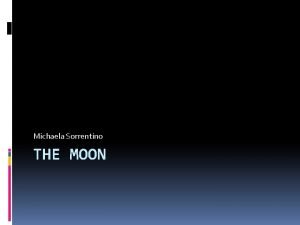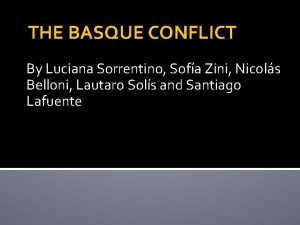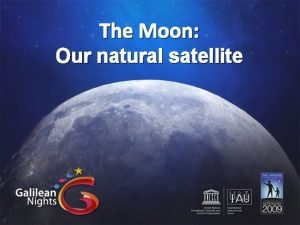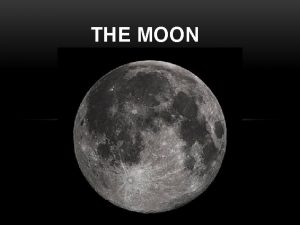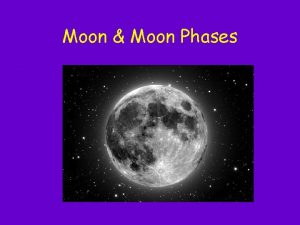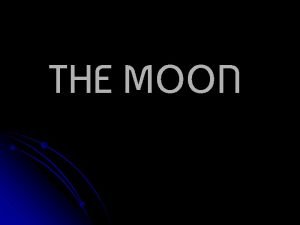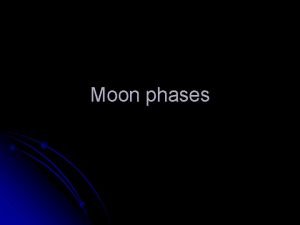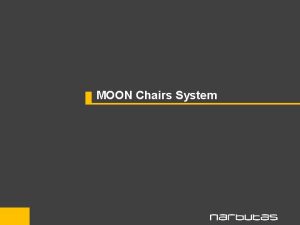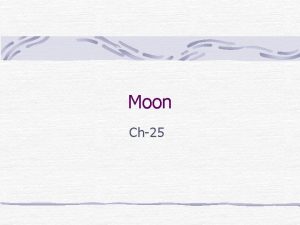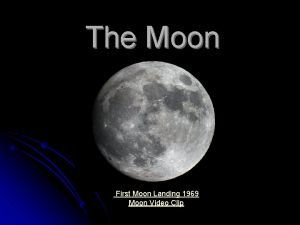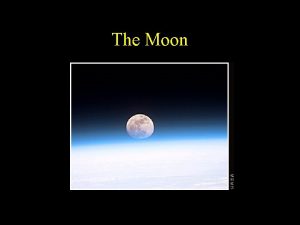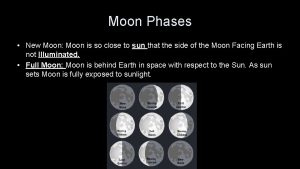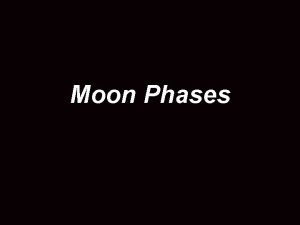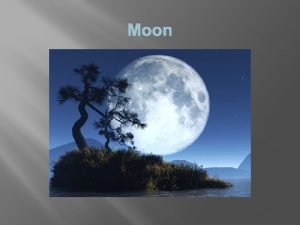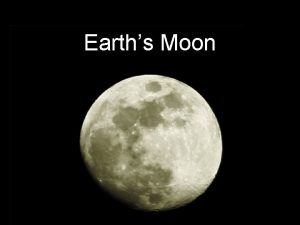Michaela Sorrentino THE MOON What is a Moon















- Slides: 15

Michaela Sorrentino THE MOON

What is a Moon? Natural satellites that orbit planets and asteroids Vary in shape, size, and make-up Moons in our solar system Mercury and Venus = 0 Earth = 1 Mars = 2 Jupiter = 79* Saturn = 53* Uranus = 27* Neptune = 13* Pluto = 5 * Have been officially confirmed https: //solarsystem. nasa. gov/moons/in-depth/

Our Moon 238, 519 miles from Earth 2, 158 miles in diameter Approx. 4. 5 billion years old Orbit around Earth = 27 Earth days https: //en. wikipedia. org/wiki/Moon Synodic period = 29 days (full moon to full moon) Gravity = 1. 62 m/s 2 (1/6 th of Earth’s)

Formation Theory: Mars-sized body (Theia) collided with Earth 4. 5 billion years ago Debris from impact accumulated and formed our moon “Magma ocean” – took 100 million years to crystallize (surface is now covered in “dark volcanic maria”) https: //en. wikipedia. org/wiki/Moon#/media/File: PIA 18821 Lunar. Grail. Mission-Oceanus. Procellarum-Rifts-Closeup 20141001. jpg

Physical Composition Has a core, mantle and a crust (just like Earth!) Core consists of solid, liquid, and partially-molten iron Very thin atmosphere Made of helium, argon, neon, sodium, potassium, hydrogen, and radon https: //en. wikipedia. org/wiki/Moon#/media/Fil e: Moon_diagram. svg

Viewing the Moon https: //www. telescopesplus. com/blogs/helpfulinformation/18963396 -how-filters-can-better-your-view Apparent magnitude ranges from -2. 5 to -12. 9 (full moon) Second-brightest “regularly visible” celestial object in Earth’s sky (the Sun is the brightest) Apparent size is about the same as the Sun’s Can be viewed with or without telescope (<50 x shows the whole moon, >150 x lets you see details of terrain) Best viewed through a telescope with neutral density filter (dims w/o coloring), well above the horizon Can view during the day

Lunar Phases https: //en. wikipedia. org/wiki/Moon#/media/File: Moon_phases_en. jpg

~All~ sides of the Moon Near Side Far Side North Pole South Pole http: //lroc. sese. asu. edu/posts/298

Eclipses https: //en. wikipedia. org/wiki/Solar_eclipse https: //en. wikipedia. org/wiki/Lunar_eclipse

Lunar Missions 100+ spacecraft have explored the Moon Soviet’s Luna program U. S. ’s Apollo, Lunar Prospector, and GRAIL 24 people have visited the Moon (12 have actually walked on it) Future exploration Moon Express: private start-up trying to land on the Moon Space. X, Vodafone, Nokia and Audi are working to install a 4 G wireless network to stream live footage of lunar surface

https: //history. nasa. gov/ap 11 ann/kippsphotos/5875. jpg

Can we see lunar landing sites from Earth? Yes! Objects too small to be seen with Hubble Lunar Reconnaissance Orbiter can! Apollo 17 Lunar Module

Fun Facts! Moon currently rotates at same rate that it revolves around Earth (synchronous rotation) We only see one side of the Moon! https: //en. wikipedia. org/wiki/Ti dal_acceleration Each year, the Moon moves an inch further away from the Earth The gravitational forces of the Sun and the Moon create tides on Earth High tides + Moon's gravity = tidal bulging Earth's rotation causes torque on the Moon; Moon moves further away from Earth & days become longer Earth used to rotate at faster rate (days are ~2 hours longer than they were 600 million years ago)

References https: //en. wikipedia. org/wiki/Moon https: //solarsystem. nasa. gov/moons/earths-moon/overview/ https: //www. space. com/14296 -moon-telescope-viewingskywatching-tips. html https: //history. nasa. gov/ap 11 ann/kippsphotos/apollo. html http: //lroc. sese. asu. edu/about https: //astrobob. areavoices. com/2012/07/28/can-you-see-theamerican-flag-on-the-moon-yes/ https: //www. telescopesplus. com/blogs/helpfulinformation/18963396 -how-filters-can-better-your-view https: //en. wikipedia. org/wiki/Lunar_south_pole https: //en. wikipedia. org/wiki/Tidal_acceleration https: //en. wikipedia. org/wiki/Tide

Thank you for your time! Questions?
 Michaela sorrentino
Michaela sorrentino Luciana sorrentino
Luciana sorrentino Fiodor sorrentino
Fiodor sorrentino Ralph sorrentino
Ralph sorrentino Moon sister moon calendar
Moon sister moon calendar Home.hiwaay.net/ krcool/astro/moon/moon tides/
Home.hiwaay.net/ krcool/astro/moon/moon tides/ Which moon phase occurs directly before a new moon
Which moon phase occurs directly before a new moon Home.hiwaay.net/ krcool/astro/moon/moon tides/
Home.hiwaay.net/ krcool/astro/moon/moon tides/ Which moon phase occurs directly before a new moon
Which moon phase occurs directly before a new moon Michaela boeche
Michaela boeche Michaela pernon
Michaela pernon Michaela frostad
Michaela frostad Iserv igs row
Iserv igs row Template matching
Template matching Michaela crawford
Michaela crawford Michaela porubanova
Michaela porubanova
